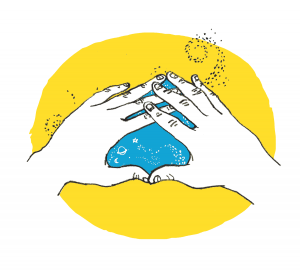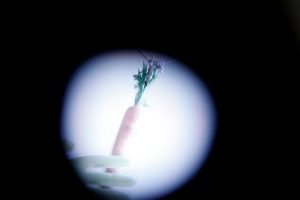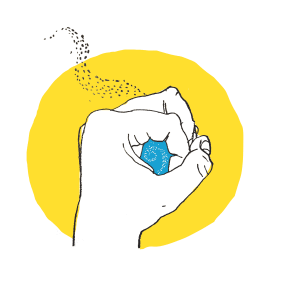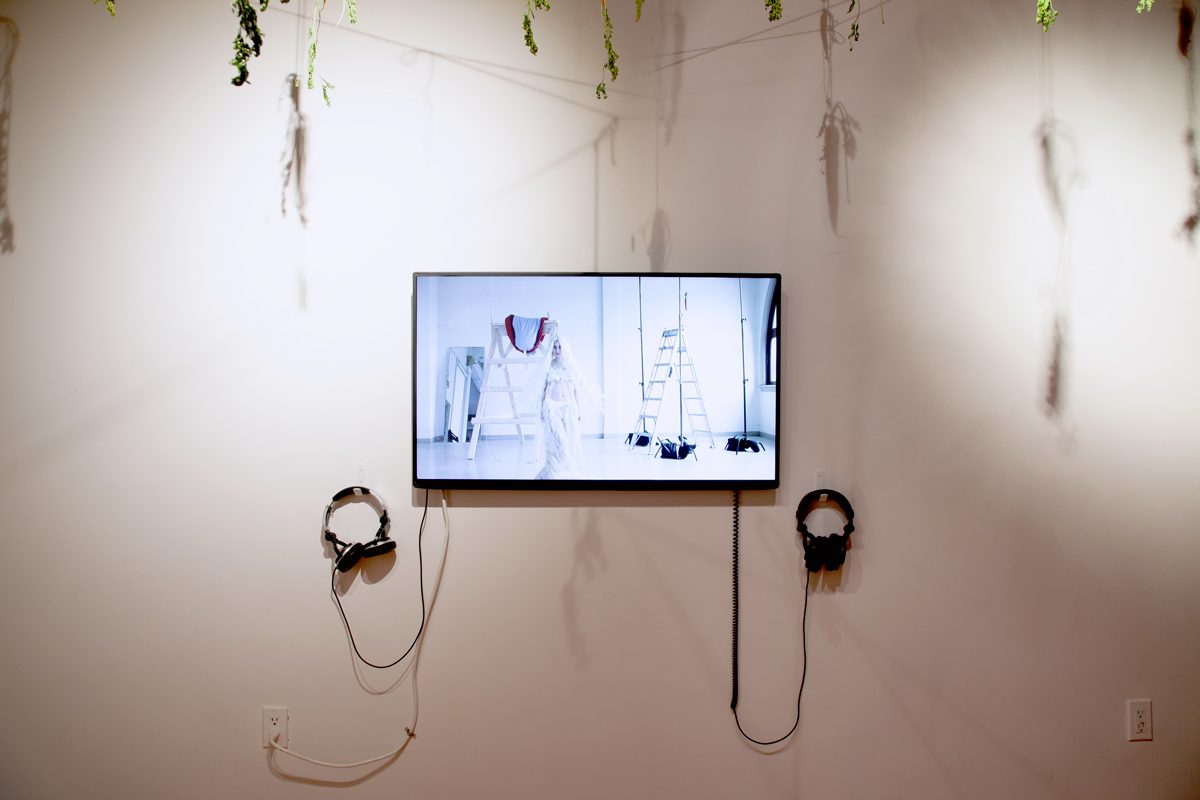“Choreography for Carrot” by Shizen Jambor opened at Ground Floor Art Centre, 735 Gore Avenue, Vancouver, on November 15, 2019.
Everyone wants to believe they’re self-aware; that they are conscious of the concessions they’ve made to play whatever games they have committed to. Choreography for Carrot, a video installation piece by Shizen Jambor, forces artists to recognize their own complacency within myths and norms of the art world. The exhibition was short-lived but immersive. It was made up of two videos centered around a fictional artist (played by Jess Waters) and ran from November 15 to 20 at Ground Floor Art Center.
One video depicts an interview with the fictional artist speaking about their art practice. The other video, which Jambor attributes to the fictional artist, shows an art piece Jambor and Waters actually executed. It was only viewable through a peephole, and in it Waters is seated on a mounted bench wearing long blonde wigs on their head and waist. They hold a pole tipped with an inflated glove, and interact with a suspended carrot in their studio, following the instructions in the show’s literature:
Stretch
Inch forward, inch forward, inch forward
Gather (collect self)
Drive hand forward
glide towards goal, feeding inches at a time
full extension
reach for it
r e e e a a a a a a c h h h h for it
swipe, swat, swat
strain, put everything into it
relax and reset
One of the most effective and endearing parts of Choreography for Carrot is the unobvious satire. Jambor knows how to be exaggerative, their recent show, High Performance Object at Charles Clark Gallery, was explicit and intentional in its exaggeration and crudeness. It was self-definedly campy. However, with Carrot there is no winking at the camera — Waters’ earnest delivery of “We live in a society,” is with sincere conviction, does not waver. It is past deadpan; it makes us sit in reality-as-ridiculousness until we realize how ridiculous it is.
In Carrot, Jambor explored the “contextualization of art on display.” Carrot’s structure was intentionally layered and implicit, contorting standard routes of interacting with pieces. The reality of the humor, the facility of the show itself, the intentionally mimicking-to-mock, forced the audience to eschew certain standards of contextualization yet made the show more dependent on others. Without the show’s literature, without being told that it is satire, you would not know. You might think the work is bad, but not intentionally. This satire is explicit in the literature accompanying the show, but the pieces themselves don’t have embedded points of entry.

The opening was simultaneous with the Eastside Culture Crawl, and the Crawler audience often takes work at face value. This transient demographic, en route to participating Crawl events, magnified those elements of inaccessible humour in Carrot The layers of reality in Jambor’s work successfully created a whole and believable world, so whole that the messages became almost over-coded. In challenging art contextualization conventions, the show also demonstrated how standardizing art-interaction allows for concise communication to a broader audience.
Still, Choreography for Carrot was not necessarily made for a broader audience. What makes it relatively inaccessible to those outside the art world made its communication to those within it more effective. Ground Floor is run by Emily Carr students and alumni, and acts as a community cornerstone for young, emerging artists who were hoping for an obvious or heightened silliness — Carrot’s satirical sincerity was not comforting. At the opening reception the interview’s audio was played off the monitor speakers and the audience watched it together, reacted together, and where Waters did not wink at the camera we winked to each other. The hyper-closeness to reality was proximal to the ways in which audience members interact with, or perpetuate myths around art production. There was a comradery in these emerging artists, collectively recognizing the goofiness of these behaviors. That comradery was comforting where the pieces were not.

Carrot’s interrogation of the conceptions of art production indicates their contradictions. Such as when Jambor and Waters’ unnamed artist claims, “if making art is difficult for someone then maybe it’s not for them,” despite the fact their own art practice focuses on struggle and striving.
The “peeped performance” is the kind of art culminated by these art-production myths. It is filmed in a large white room, the fictional artist is intent, they “put everything into it”. It alludes to the Lady Godiva legend, but is too dependent on the associations it expects its audience to already have made and does not say much itself.
Jambor seriously and steadily holds a mirror up to the art world and tells it that it is silly — providing itself as a negative for how artists can approach their practice.


